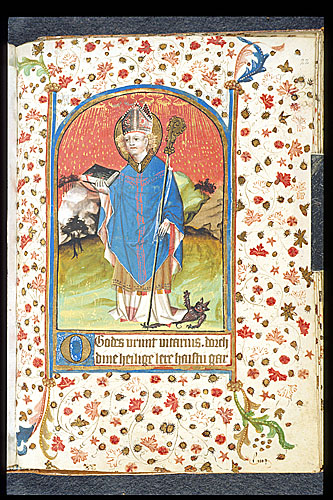At some point in the first half of the eleventh century, Archbishop Poppo of Trier (1016-1047) decided to commission a new pair of pontifical stockings. He sent some material to a young canoness who belonged to a nearby religious house; shortly afterwards, he received his new footwear, and decided to try them on. The stockings were almost perfect, but they had one major flaw.

According to the chronicler who recorded the incident, the canoness ‘desiring to have [the wearer] partake of her lewdness, poisoned them with what kind of magic art I do not know’. Consequently, when Poppo put the stockings on, he was overcome with lust for the woman, and felt that his life would not be worth living if he could not have sex with her. Taking them off, he called over one of his priests, and told him to put the stockings on. The priest did so, then immediately took them off, exchanging a look with the bishop but saying nothing. A whole succession of clerics donned the stockings, and all ‘suffered similar things.’ Finally, a prefect of the city arrived, and the bishop ordered him to try on the stockings. Furiously, the layman declared that he had been bewitched, and demanded an explanation. Poppo revealed the perpetrator of this evil deed, and the clergy unanimously condemned this outrageous attack on their church.
To a modern audience, this seems like a rather ridiculous tale, perhaps even one indicative of the simplicity of the medieval mind. How, we might ask, could a whole group of men possibly be bewitched by a humble pair of stockings? If the canoness wanted to seduce the bishop, surely there were better ways of going about it? And why on earth was it necessary for every cleric in the sacristy to try on the offending footwear?
However, this is actually a story with rather sinister undertones, not least because it reflects the extreme misogynistic tendencies which were deeply entrenched in medieval ecclesiastical culture. Many clerics struggled to keep their vows of celibacy, and it was all too easy to blame women for deliberately tempting vulnerable men. This was certainly the outcome in this case. Whilst the men concerned were presented as innocent victims of an evil attack, the women involved were harshly punished. The seamstress was immediately expelled from her community, and the other canonesses (who had played no part in the incident at all) were placed under such a harsh regime that many of them resisted and the entire community was shut down.
But the bishop’s harsh response to this incident was not solely motivated by hatred of women. Medieval people took magic – including love magic – extremely seriously, and thought that it had real potential to do both physical and spiritual harm. Consequently, it is unsurprising that they were genuinely concerned, and even frightened, when confronted by cases such as these: a women who used her own menstrual blood (mixed with food or drink) to force her husband to love her more; a newly-married man left impotent by the spells of his jealous ex-girlfriend; a priest who used ‘conjurations and incantations’ to make a married woman come to his chamber by night ‘so that he could violently oppress her in adultery.’ As the last of these cases demonstrates, love magic was not only practised by women, although clerical authors (probably motivated by a combination of misogyny and concern about their own vulnerability) do seem to have been particularly concerned by female practitioners of the art.
Since magic could have such serious consequences, the clergy had a moral and spiritual duty to condemn its practitioners. Confessors’ manuals insisted that priests should inquire about both men and women who claimed to be able to change love to hate or hate to love. Those accused of using love magic might find themselves hauled before the ecclesiastical courts, particularly if they were also suspected of other sexual offences such as adultery or prostitution, and those falsely accused of such practices might be obliged to seek ecclesiastical protection. In a world which took magic and the supernatural so seriously, Archbishop Poppo had no choice but to act harshly against the perpetrator of such a terrible crime, both for his own sake and for that of the large number of souls for which his office made him responsible. At a distance of a thousand years, Poppo’s response may seem vastly overdramatic, but in medieval Europe aphrodisiacal stockings were no laughing matter.
 Katherine Harvey is an Associate Lecturer at Birkbeck College, University of London where her research focuses on the pre-Reformation English episcopate. Her first book, Episcopal Appointments in England c.1214-1344, was published by Ashgate in January 2014. Katherine’s current project combines ecclesiastical history with the history of gender, sexuality and medicine. She tweets from @keharvey2013
Katherine Harvey is an Associate Lecturer at Birkbeck College, University of London where her research focuses on the pre-Reformation English episcopate. Her first book, Episcopal Appointments in England c.1214-1344, was published by Ashgate in January 2014. Katherine’s current project combines ecclesiastical history with the history of gender, sexuality and medicine. She tweets from @keharvey2013

NOTCHES: (re)marks on the history of sexuality is licensed under a Creative Commons Attribution-NonCommercial-NoDerivatives 4.0 International License.
Based on a work at www.notchesblog.com.
For permission to publish any NOTCHES post in whole or in part please contact the editors at NotchesBlog@gmail.com





Reblogged this on Going Medieval and commented:
Great post by Katherine Harvey!
There has been a revival of magic practitioners every hundred years or so. This story comes to us from (1016-1047). I am not a fan of clerical oppression of women and their magicks. Especially between (1600 – 1700’s) women were persecuted, exiled, burned at the stakes, etc, etc. Many of these women were just midwives. The Poppo here sounds crazier than a woman who would bewitch a pair of stockings, in private if indeed she did so, and this guy here (whistle) crazy people. Isn’t it interesting how the canoner was tried and convicted without a shred of evidence or even being present?
But that’s how patriarchy was established. Those men had to put the women in their proper places and look where it got us.
We must be careful in assigning this episode to the “simplicity of the medieval mind.” The incident related by Harvey is educational and entertaining. It is vitally important to continue to document these sorts of acts precisely because they are not medieval but contemporary. While it stinks of misogyny, the mentality behind it ranges far more broadly. We still today have to spend too much time defending evolution and even science itself. Harvey’s anecdote is more than a faded snapshot; it’s a reminder.
Reblogged this on Games From Folktales and commented:
A little medieval love magic, to test reblogging
Pingback: WordPressers Making a Splash - WP Creative
I don’t see any evidence of misogyny in the bishop’s reaction. If anything, his behavior seems quite rational, even scientific!